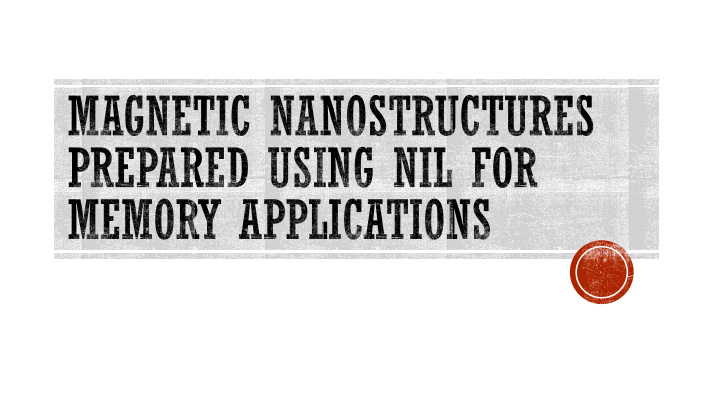



Stored by digital magnetic storage Concept: for a small region of ferromagnetic material to be in one of two well- defined magnetisation states, thus corresponding to a binary number A sequence of these regions will allow us to store useful data (e.g. 1011011011001) A magnetic field can be used to alter the magnetisation states of each region separately, thereby writing magnetic data
Magnetic recording trilemma: Signal to Noise Ratio, writability and thermal stability which limits the grain size Limits areal density to 1Tb in -2 To resolve: Bit Patterned Media (BPM) or Heat Assisted Magnetic Recording (HAMR) In our study, we will be focusing on BPM, which allows a single grain to occupy a single magnetic island
By allowing one single magnetic grain to occupy each magnetic island, grain size can be optimised to increase the areal density
Electron Beam Lithography (EBL) Nanoimprint Lithography (NIL) Self Assembly Interference Lithography (IL) In our study, we will be focusing on nanoimprint lithography
Nanoimprint lithography – a low cost process to create nanostructures and patterns by the mechanical deformation of the resist Resist is cured by UV radiation Used to make magnetic nanostructures to store data
Deposition of magnetic films atop substrate Spin coating of resist on magnetic films Pressing of template into resist Curing of resist using UV light Reactive Ion Etching (RIE) Treatment of Piranha solution (mixture of sulfuric acid and hydrogen peroxide)
Resist is then cured by UV light.
- Removes exposed magnetic films and resist
- Mixture of sulfuric acid and hydrogen peroxide used to dissolve residual resist
To lower the cost of production of making BPM using RNIL (reverse nanoimprint lithography) Quality of nanostructures formed (uniformity, edge defects, etc.) must be the same as those produced using conventional NIL
‘ Reverse Nanoimprint Lithography (RNIL) for Fabrication of Nanostructures’ by A. Tavakkoli K. G., M. Ranjbar, S. N. Piramanayagam, S. K. Wong, W . C. Poh, R. Sbiaa and T.C. Chong The only paper to research on RNIL Shows us the potential for RNIL to be used in place of conventional NIL
We are trying to find the method to fabricate nanostructures of the highest uniformity and least edge deformities This is because it will allow magnetisation state of each individual magnetic nanostructure to be more stable and more writable, while also being less susceptible to superparamagnetism* *Superparamagnetism: situation where magnetic nanostructures affect magnetisation state of other adjacent magnetic nanostructures
Hypothesis: RNIL can be used to fabricate NiFe (magnetic) nanostructures Independent variable: method of fabricating nanostructures (NIL or RNIL) Dependent variable: the presence of nano patterns Results from NIL is used as a positive control
Atomic Force Microscopy (AFM) is used to inspect the nanostructures formed using RNIL and NIL Images of nanostructures fabricated by NIL Images of nanostructures fabricated by RNIL
Under the SAME imprinting conditions, NIL produced nanostructures of lesser edge deformities than RNIL RNIL, however, still fabricated observable nanostructures which can still possibly be used for domain wall dynamics
It is possible for us to make use of RNIL and NiFe to form nanostructures for domain wall dynamics By referencing from the study ‘ Reverse Nanoimprint Lithography (RNIL) for Fabrication of Nanostructures’ , it is possible to optimise the nanostructures by reducing the pressure and temperature in the imprinting step and including a baking step after that This could potentially lower the cost of fabricating nanostructures, especially when this experiment is conducted on a relatively cheap ferromagnetic material, NiFe, which is viable for commercial use
We would like to optimise the RNIL process by changing the pressure and temperature during the imprinting step (130°C, 6 bars, 1 min) to produce nanostructures with less edge deformities and higher uniformity From the same study previously, we might want to try and use a flexible mould so that the separation of the mould and the resist would be smoother, achieving nanostructures of higher uniformity
- ‘ Reverse Nanoimprint Lithography (RNIL) for Fabrication of Nanostructures’ by A. Tavakkoli K. G., M. Ranjbar, S. N. Piramanayagam, S. K. Wong, W . C. Poh, R. Sbiaa and T.C. Chong
Recommend
More recommend